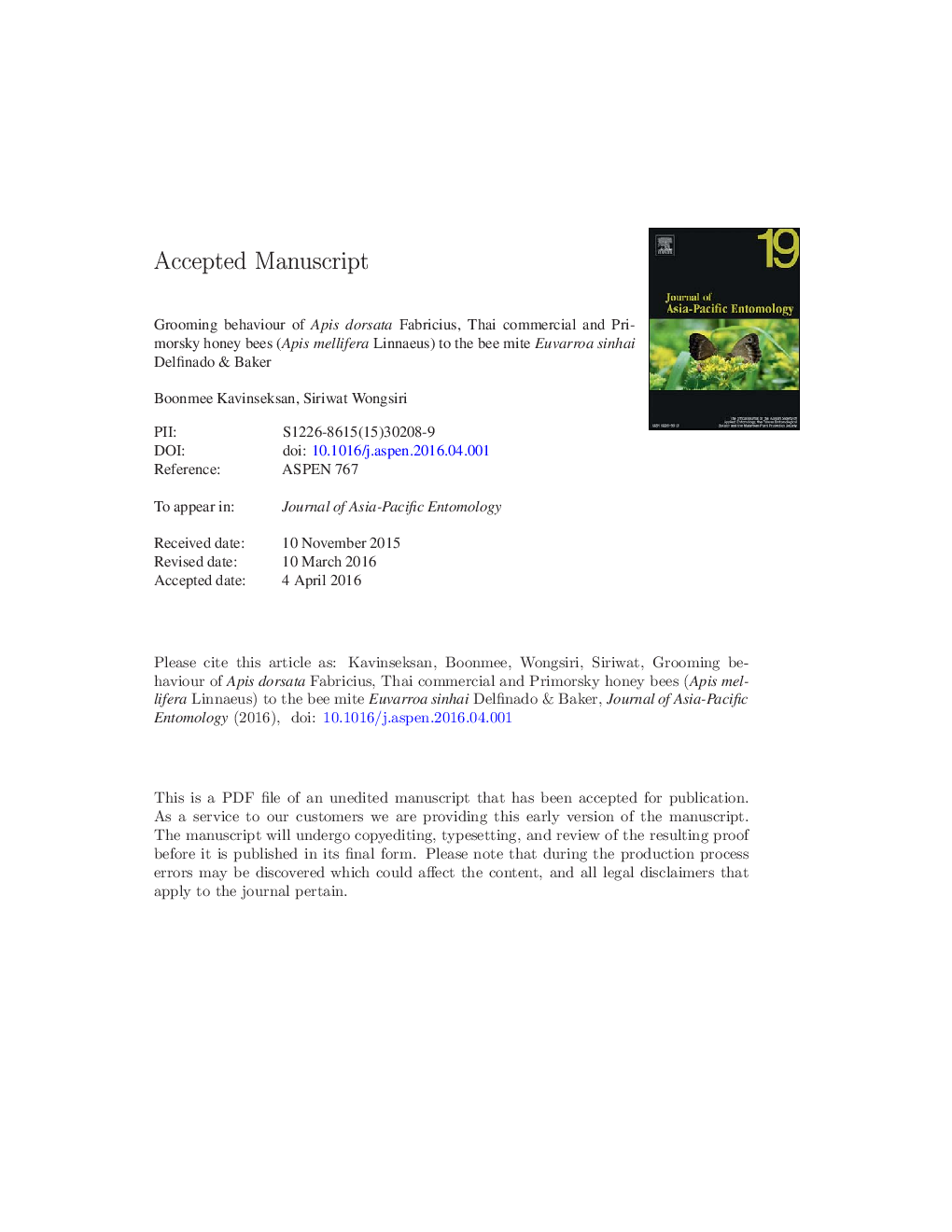| کد مقاله | کد نشریه | سال انتشار | مقاله انگلیسی | نسخه تمام متن |
|---|---|---|---|---|
| 6380002 | 1323573 | 2016 | 24 صفحه PDF | دانلود رایگان |
عنوان انگلیسی مقاله ISI
Grooming behavior of Apis dorsata Fabricius, Thai commercial, and Primorsky honey bees (Apis mellifera Linnaeus) to the bee mite Euvarroa sinhai Delfinado & Baker
دانلود مقاله + سفارش ترجمه
دانلود مقاله ISI انگلیسی
رایگان برای ایرانیان
موضوعات مرتبط
علوم زیستی و بیوفناوری
علوم کشاورزی و بیولوژیک
علوم دامی و جانورشناسی
پیش نمایش صفحه اول مقاله

چکیده انگلیسی
The purpose of this study was to determine grooming behavior efficacy of Apis dorsata, Thai commercial (A. mellifera, Italian honey bee hybrids), and Primorsky honey bees (A. mellifera) in killing the mite species Euvarroa sinhai. Ten A. dorsata, 15 Thai commercial and 15 Primorsky colonies were used to compare efficacy in their grooming behavior related to E. sinhai. Fallen E. sinhai from A. dorsata colonies was collected using a white plastic sheet (1.4 Ã 2 m), which was smeared by vegetative oil and placed 1 m below each colony. The fallen E. sinhai on the plastic sheet were collected weekly until the colony was absconded. Dead E. sinhai from each colony of Thai commercial and Primorsky honey bees were collected by the use of mite collecting boards with wire screens. The boards were coated with a thin film of vegetable oil and maintained in the hives for periods of 7 days until the end of the experiment (12 months). Dead mites on the traps from A. dorsata, Thai commercial, and Primorsky colonies were retrieved by the use of a fine paint brush and examined for their injuries using a stereomicroscope at 40 à magnification. Injuries obtained by the mites were classified as either injured legs only or injured both legs and body. The data on percent means of injured mites from colonies of the three bee types were analyzed using one-way ANOVA for a completely randomized design, and the means were compared using Duncan's new multiple range test. The results showed that A. dorsata workers had more efficient grooming behavior to kill E. sinhai than the Primorsky and Thai commercial bees, respectively. The percentage of injured mites in the A. dorsata debris (55.4 ± 2.2%) was significantly higher (P = 0.001, df = 37) than that of the Thai commercial (18.6 ± 1.6%) and Primorsky (41.4 ± 2.1%) debris (percent mean ± standard error), and the percentage of injured mites in the Primorsky debris was significantly higher than that of the Thai commercial debris. The percentage of mites that had severely injured both legs and body in the A. dorsata debris (42.0%) was higher than that of the Thai commercial (31.8%) and Primorsky (36.0%) debris. Mites that had injured legs only from the A. dorsata, Thai commercial, and Primorsky debris were 58.0%, 68.2%, and 64.0%, respectively.
ناشر
Database: Elsevier - ScienceDirect (ساینس دایرکت)
Journal: Journal of Asia-Pacific Entomology - Volume 19, Issue 2, June 2016, Pages 359-363
Journal: Journal of Asia-Pacific Entomology - Volume 19, Issue 2, June 2016, Pages 359-363
نویسندگان
Boonmee Kavinseksan, Siriwat Wongsiri,